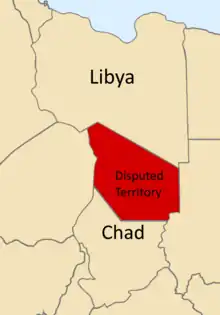Libya–Chad Territorial Dispute case
The Case Concerning the Territorial Dispute (Libyan Arab Jamahiriya/Chad) [1994] is a public international law case decided by the International Court of Justice (ICJ) concerning the border between the Libyan Arab Jamahiriya and the Republic of Chad. The case was put forward to settle a territorial dispute between the two countries, particularly over a strip of land called the Aouzou Strip which Libya had occupied since the Chadian–Libyan War, and an area which Libya called the Libya–Chad Borderlands or simply the Borderlands.[1][2] Libya's claim of the Borderlands included parts of the regions of Borkou, Ennedi and Tibesti, including the localities of Erdi, Kanem and Ounianga.[3][4]
| Libyan Arab Jamahiriya v. Chad | |
|---|---|
 | |
| Court | International Court of Justice |
| Full case name | Case Concerning the Territorial Dispute (Libyan Arab Jamahiriya/Chad) |
| Decided | 3 February 1994 |
| Court membership | |
| Judges sitting | Jennings, Oda, Ago, Schwebel, Bedjaoui, Ni, Evensen, Tarassov, Guillaume, Shahabuddeen, Aguilar Mawdsley, Weeramantry, Ranjeva, Ajibola, Herczegh ad hoc: Abi-Saab and Sette-Câmara |
| Case opinions | |
| The boundary between the Libyan Arab Jamahiriya and Chad is defined by the Treaty of Friendship and Good Neighborliness (1955) | |
| Concurrence | Ajibola, Ago, Shahabuddeen |
| Dissent | Sette-Câmara |

Libya argued that there was no existing boundary between itself and Chad and asked the court to define one. It also claimed that it had clear rights to territory north of a demarcated line which was on the 15th parallel north for much of its length. Libya called this area the Libya–Chad Borderlands; this was the disputed territory between Chad and Libya.[1] Chad on the other hand argued that there was an existing border and asked the court to define it.[5] It maintained that the Aouzou Strip was part of its territory.[2] Chad's territorial claim was based on the 1955 Treaty of Friendship and Good Neighborliness between France and Libya which would place the Aouzou Strip within the borders of Chad.[1]
The case was decided on 3 February 1994. The ICJ ruled in favor of Chad against Libya and declared Libya's occupation of the Aouzou Strip illegal.[5] The court recognised Chad's territorial claim and sovereignty over the Borderlands and Aouzou Strip.[6][7]
Facts
The Aouzou Strip is a barren piece of land located on the border of Chad and Libya. Libya had begun to stage troops on the strip in order to assist with the defense of its citizens who lived in the area. Despite the land having no strategic or functional value to Chad, the government saw the Aouzou Strip as part of their sovereign territory. Due to the inability of both countries to internally establish a line of demarcation, the case was referred to the International Court of Justice for adjudication in 1990.
Each country has a differing basis from which it is deriving its claims of the Aouzou Strip:
- Libya's claim is on "the basis of a coalescence of rights and titles of the indigenous inhabitants, the Senoussi Order, the Ottoman Empire, and through an agreement that its government made with Italy."
- Chad has argued that the border was established through the Treaty of Friendship and Good Neighborliness which was concluded between France and Libya in 1955.
From Libya's perspective, there is not enough evidence to show that a boundary was ever established and that they have adequately lay claim to the Aouzou Strip through administrative control. Chad's use of the Treaty of Friendship and Good Neighborliness as basis of its claim has also been challenged due to the treaty being in effect for only 20 years (1955-1975).
Judgment
The case was decided on 3 February 1994.[6][7] The ICJ ruled that the boundary between Chad and Libya is defined by the Treaty of Friendship and Good Neighborliness which was concluded between France and Libya in 1955.[6] Conversely, this recognised Chad's territorial claims and gave it territorial sovereignty over the Aouzou Strip and the Borderlands. Libya's occupation of the strip was declared illegal.[5]
See also
References
- Lauterpacht, E.; Greenwood, C. J.; Oppenheimer, A. G. (5 October 1995). International Law Reports. Cambridge University Press. ISBN 978-0-521-49647-6.
- "INTERNATIONAL COURT OF JUSTICE: CASE CONCERNING THE TERRITORIAL DISPUTE (LIBYAN ARAB JAMAHIRIYA/CHAD)" (PDF). United Nations. 3 February 1994. Retrieved 15 October 2023.
- "Case Concerning the Territorial Dispute (Libyan Arab Jamahiriya/Chad)". International Law Reports. 100: 53. January 1995. doi:10.1017/CBO9781316152294.001. ISSN 0309-0671.
- Ibrahim, Talal; Shelbi, Moh. (2017). "LIBYAN–CHADIAN CONFLICT (1976-1994)" (PDF). Atilim University. p. 58. Retrieved 15 October 2023.
- Blake, Gerald (April 1994). "A Note on the International Court of Justice Ruling on the Chad-Libya Dispute" (PDF). Durham University. Retrieved 15 October 2023.
- "Summaries of Judgments, Advisory Opinions and Orders of the International Court of Justice: CASE CONCERNING THE TERRITORIAL DISPUTE (LIBYAN ARAB J'AMAHIRIYAICHAD)" (PDF). International Court of Justice. 3 February 1994. Retrieved 15 October 2023.
- "Communique: Case concering Territorial Dispute (Libyan Arab Jamahiriya/Chad)" (PDF). International Court of Justice. 3 February 1994. Retrieved 15 October 2023.